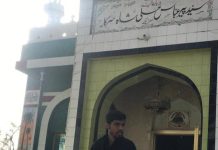Quetta: The wild olive forests in Balochistan is under threat to be eradicated forever as local communities use it for fuel, sheltering and grazing.
The natural olive forests fall in the category of Dry Subtropical Broad-leaved Forests, occurring at an altitude range of 450-1500 m and in areas which receive rainfall from 250-750 mm rainfall, well distributed in winter and summer seasons. Its associated species on the upper altitudinal range are Pistaciakhinjak (Wild Olive; Shana) and Fraxinusxanthoxyloides (Wild Ash); and on the lower altitudinal range are Acacia Modesta (Phulai) and Dodonaeaviscosa (Sanatha).
Total estimated area of olive forests in Balochistan is 0.2% of the Province out of which, 80% is owned by the communities and 20% by Government as State Forests. Climatically, these forests are located in Monsoon range with annual average rainfall between 250-750 mm.
Lawyer Salam Khan Mandokhail, a resident of Zhob district, told News Lens Pakistan that the people of his area are poor and don’t have any alternate source to cover themselves from the chilly weather; nor they have anything else to graze on cattle except the forest. “Communities in the district had sworn not to cut the forest; but by the passage of time and economic pressure the lower class of poor started to cut and stock the woods for keeping themselves warm in winter,” he added.
He also said that the law enforcers are either absent or part of the local community, so they never interfere in “forest cutting” otherwise it will lead to tribal feuds.
“These forests are generating a list of goods and services for the dependent communities while playing diversified roles; either productive role (as provider of forage for livestock and wood to burn, protective role (as protection of environment, biodiversity bank, and soil conservation), or regulatory role (as water regulation in the catchment areas),” Ali Imran Deputy Chief Conservator Forest Zhob Division told News Lens Pakistan.
“Irony is that we look only on tangible things and overlook intangible services. To make the Olive Forest more productive we need to look into anthropogenic pressures (cutting for fuel-wood and over-grazing) and to rationalize them for sustainable supply of goods and services from these forests,” Imran told News Lens Pakistan.
On anthropogenic aspect, these forests are heavily used by the communities for fuel-wood, lopped for fodder and openly grazed. Its seed is edible and locally consumed. Natural regeneration is promising, but it is affected by heavy and open grazing.
“In past some efforts have been made for top-working of cultivars of Olea europaea (European Olive) on Wild Olives, but in my view and also of technical community, it’s neither suitable nor feasible because at one hand it make changes in biodiversity and on the other hand productivity is not that much if European olive is grown in orchard condition,” Ali further said.
Sharifuddin, a resident of Homzha village, Zhob district, told News Lens Pakistan that thirty or forty years ago, the area was covered with the Olive Forest, when increased population and equipment use “destroyed” every standing tree including the “Wild Olive Forest”.
“I knew cutting forest would impact the weather and life in near future; but what could I do, we were advised by our elders to cut the trees in competition with our cousins. No awareness regarding the importance of forest exists, the tribal feuds and competition between the clans proves to be destructive toward the Olive Forests”.
Faiz Kakar Program, manager of the IUCN, Balochistan chapter, told News Lens Pakistan, “If the government and communities don’t take care of these forests, we would see a change in the climate, as we observe the summer become hotter and the winter colder that becomes unbearable for the locally existing species.”
According to Kakar, the Forest department should be provided with better monitoring tools, locals should be provided with alternative fuels like methane gas for burning, laws regarding the forest cut needs to be changed.
The best surviving Olive forests are those under the control of the government; area of Government Managed Olive Forests (in the northern part of Balochistan) under the control of Forest Department.
“On one hand, we are gradually improving government forests. Forestry is long term activity and results take time to be more visible,” Ali Imran Deputy Chief Conservator Forest Zhob Division told News Lens Pakistan.
Economic inequalities have forced resource dependent communities for more reliance on these forests. “Changing climate pattern and two anthropogenic pressures (cutting for fuel-wood and over-grazing) are complex issues; poverty is a major factor in accelerating the rate of degradation in these forests,” Ali added.
Juma Rahim Mandokhail, 70, a tribal elder, says the locals cut the forest woods to earn money to pay lawyers for tribal feuds in courts. “Our people are not having resources to get money from; most of our youth is in U.A.E and Saudi Arabia to earn their families’ bread. The elders have taken the issue of forest cutting to the court,” he said.
Ali Imran was of the view that for a sustainable management of these forests, first we need to focus on economic improvement of the population, which is futile without education. Then we need to integrate local population in management of these forests, because it’s an established fact that communities surviving on natural resources have, by necessity, a detailed and profound knowledge of their resources for their own subsistence.
Ali concluded the key to conserving these forests lies with local communities; which could enable us for understanding social reasons of current natural resource deterioration in the area and finding socially acceptable technical solutions.



